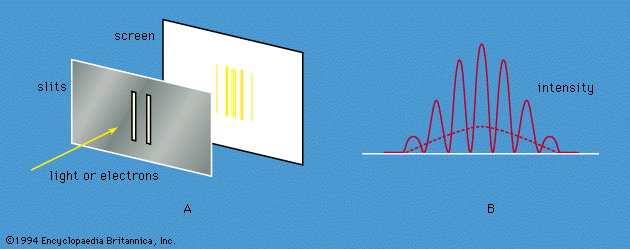
Interference in optics is the net effect of the combination of two or more wave trains moving on intersecting or coincident paths. The effect is that of the addition of the amplitudes of the individual waves at each point affected by more than one wave.
If two of the components are of the same frequency and phase (i.e., they vibrate at the same rate and are maximum at the same time), the wave amplitudes are reinforced, producing constructive interference; but, if the two waves are out of phase by 1/2 period (i.e., one is minimum when the other is maximum), the result is destructive interference, producing complete annulment if they are of equal amplitude.
When two stones are dropped into a pool of water, waves spread out from each source, and interference occurs where they overlap. Constructive interference results where the crest of one coincides with the crest of the other. Two wave trains of light from a double slit produce interference, an effect that is visible on a screen as a pattern of alternating dark and light bands caused by intensification and extinction at points at which the waves are in phase and out of phase, respectively.

(A) Monochromatic light incident on a pair of slits gives interference fringes (alternate light and dark bands) on a screen, (B) variation in the intensity of the light at the screen when both slits are open. With a single slit, there is no interference pattern; the intensity variation is shown by the broken line.
Excerpt from the Encyclopedia Britannica without permission.